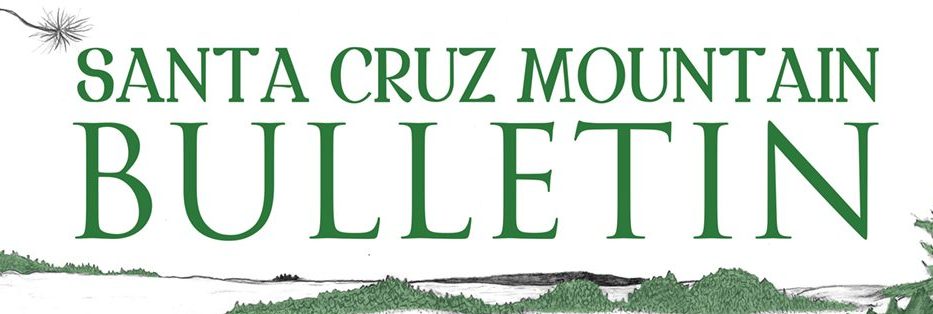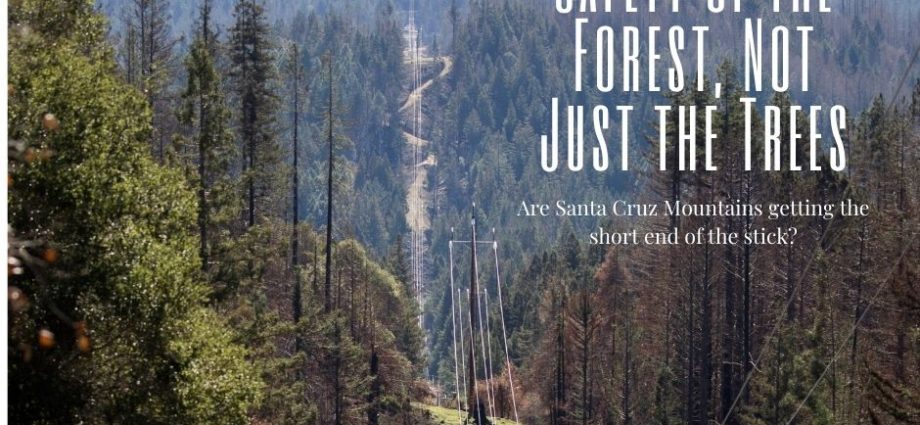Are Santa Cruz Mountains getting the short end of the stick?
by Wendy Sigmund & Lori Suzanne Holetz
Trees are being removed in great numbers here in the Santa Cruz Mountains. Some are felled by private companies like Anvil, some by property owners and some by the utility company Pacific Gas & Electricity, PG&E. There are local residents who are claiming PG&E is felling trees without property owner’s permission and leaving the trees and slash where they fall for the owners to clean up on their own. PG&E, has been given a mandate to improve its wildland fire danger record. The California Public Utilities Commission, CPUC, along with the California Wildfire Safety Advisory Board are supposed to hold the utility company accountable. They created the Enhanced Oversight and Enforcement (EOE), which lays out a process for holding PG&E accountable for greatly reducing the fire danger PG&E has caused in the past. The consequences for not achieving the board’s goal are that they could revoke PG&E’s license and arrange for a takeover. The CPUCs EOE identifies specific events that will trigger six enforcement steps of increasing operational oversight. Those six steps are: Resolution M- 4852 of the CPUCs Corrective Action Plan for EOE was approved and goes into effect with the first report due to CPUC by May 5, 2021. This already appropriately places PG&E into Step 1 of the EOE process due to a triggering event. PG&E wrote on their website that the stockholders should not be concerned because they are addressing the issues and can then be moved back down the tiered Steps. An audit in 2020 by the Wildfire Safety Division has shown that PG&E did not sufficiently prioritize its EOE based on risk. Step 1 triggers a requirement for PG&E to submit a Corrective Action Plan for approval, reporting on 13 measures identified in Resolution M-4852 by May 5th 2021, and every 90 days thereafter. PG&E will be required to explain how they will prioritize the highest risk power lines in its Enhanced Vegetation Management (EVM) program in 2021, provide accurate reporting to the Commission where they are performing work and must keep the Commission apprised of any changes. The goal is to hold PG&E accountable and responsible for operations. The Commission calls for public transparency, the opportunity for the public to be invited, view, participate and comment on all the steps in these decisions. All corrective action plan reports will be made publicly available. Specific details of each step can be found at www.cpuc.ca.gov PG&E has done some work on vegetation but the Commission says not enough and not in a good time frame. CPUC Resolutions WSD-002, WSD-003 require PG&E to use a system of risk prioritization for all wildfire mitigation including decisions concerning where to target its EVM work. The Utility completed less than 5% of that EVM work; less than 92 miles of the top 20 highest risk circuits, of the 1800 total miles completed. Instead, PG&E’s lower risk circuits received the utilities greatest focus in 2020, the opposite of the desired result. Here in the Santa Cruz Mountains we see it through a slightly different lens. The trees are allegedly being cut on private property. They have cut the trees which would be viable for new growth according to some property owners. Looking into this issue we spoke with one PG&E employee who says that cutting trees is expensive so PG&E is not going to randomly take trees without a good reason. There are arborists who are on site and determining if a particular tree is viable or not. The tree could fall and hit power lines or structures. They (PG&E) do not want to spend money if it is not necessary. Cutting trees their arborists say need to come down, is necessary. Usually the company cuts the tree and takes away the slash. It is a service they provide to keep communities safe and keep the power on. If there is a problem then there is a number residents can call to make sure they do not remove trees the landowner does not want them to. That number is 800-PGE-5000. “PG&E disagrees with the characterization that our tree removal work is illegal. We understand the County, agencies and community concerns regarding this emergency hazard tree removal work and are committed to continuing to address these items with all stakeholders while prioritizing public safety, prompt restoration of electric service and environmental stewardship.” PG&E spokeswoman Mayra Tostado said in an emailed statement to Dale Kaser of the Sacramento Bee. During a meeting held virtually many callers were upset that the strategy to keep our areas safe from wildfires was to remove trees. Many argue that there would not be a problem with the trees if PG&E would improve its infrastructure. Updating transformer boxes and using isolated power lines is a better solution. “It’s been a longstanding problem with PG&E, instead of doing the responsible thing and investing in their infrastructure, they want to just do vegetation management,” said Assemblyman Mark Stone as reported in the Santa Cruz Sentinel. Please use the phone number and website to keep informed regarding the future of the safety of the forest, especially our trees.


